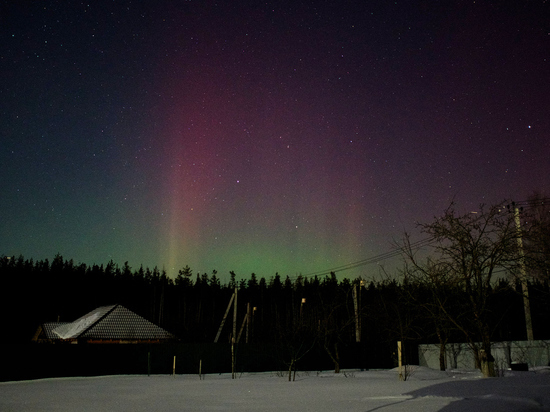Astrophotographers captured a colorful «watercolor» in the night sky
This historical fact has finally come true: the aurora borealis has almost «reached» Moscow. More precisely, they quite clearly saw him in the Moscow region, on the border between the Shatursky and Orekhovo-Zuevsky districts on the night of February 28, and even managed to photograph him. The aurora was caused by a powerful solar flare on the Sun, which occurred on February 24, and was accompanied by a very strong geomagnetic storm. The correspondent of «MK» learned the details of the event.
 Aurora Borealis near Moscow, on the border of Shatursky and Orekhovo-Zuevsky districts. Photo: Daniil Vitushkin
Aurora Borealis near Moscow, on the border of Shatursky and Orekhovo-Zuevsky districts. Photo: Daniil Vitushkin
There are a lot of Muscovites who dream of seeing the northern, or polar, lights. Particularly active people even book tours to the Murmansk region during the period of special solar activity. However, miracles happen, and now the aurora borealis has come to Moscow by itself: astrophotographers who hunt for such events have begun to record a natural phenomenon in the night sky.
Daniil Vitushkin, who lives on the border of the Shatursky and Orekhovo-Zuevsky districts, is not the first to encounter aurora at the latitude of Moscow. Since technology has taken a significant step forward (from about 2015-2017), faint auroras in our area have been detected more and more often.
But still, to see such a spectacle with a simple eye, yes, even and capture on camera, you have to work hard.
Daniel and like him, hunters of the auroras knew that on February 24 there was a powerful flash on the Sun, they knew that a strong magnetic storm should occur on Earth as a result and waited for the radiance fully armed. The result was a picture with a multi-colored «watercolor» on a black sky, which Daniil shared with MK.
“Of course, there is a normal mode and a small color correction with increased contrast,” explains the author of a unique image. – In principle, this photo, like any other night shot with stars, was processed after shooting.
The current aurora surprised even the residents of the city of Apatity, in the Murmansk region. If earlier they saw mostly green-blue gamut in the sky during a geomagnetic storm, then on the night of February 28, the sky turned red. According to experts, this is extremely rare and is due to the fact that the colorful «show», which usually appears at an altitude of 80-100 km, has reached an altitude of 400-500 km.
 The flight path of a Finnish airliner turning 360 degrees due to the aurora
The flight path of a Finnish airliner turning 360 degrees due to the aurora
It was this unusual sight that made Finnish Airlines pilots turn their aircraft 360 degrees. The passengers decided that the pilots decided to please them by going on the second run. However, the reason for such a turn could be the pilots' fear of a possible collision with a large stream of charged particles that accompany the auroras, because they can disable radio equipment.
— I ask the head of the Center for Space Weather Forecasts, Deputy Director for scientific work of the Institute of Terrestrial Magnetism and Radio Wave Propagation of the Russian Academy of Sciences (IZMIRAN) to Artem Abunin.
— We really recorded a very large geomagnetic disturbance, which lasted throughout the day on February 27 and ended only at 9.00 on the 28th, — explains the scientist. — This is one of the largest geomagnetic storms in the 25th cycle of solar activity, which began in 2019, and one of the strongest in the last two cycles. In my memory, the last time this happened was only in September 2017. According to preliminary data, a very large Kr8 class geomagnetic storm raged on Earth all the previous day (with a maximum, extreme — Kp9).
— I would be surprised if it were not there now . Somewhere not in the north or in the east of the Moscow region, where there was no urban illumination, it could certainly be seen.
— Solar flares occur periodically. In order for a bright spectacle to appear in the sky, it is necessary that they be powerful, with the release of a large amount of plasma in the direction of our planet. This plasma flies for 2-3 days (the fastest recorded arrival is after 19 hours). Exactly such large flares, which gave birth to large emissions of solar plasma, appeared on the Sun on February 24 and 25. It was this plasma, which reached the Earth on February 27, that “rocked” our atmosphere, generating geomagnetic storms, and “ignited” the auroras.
— Yes. Only until 2008 we did not have the technology that could catch them, and after solar activity began to decline. The fact is that the previous 11-year cycle, which began in 2009, the Sun produced very few flares. A new cycle has begun in 2019, it is a little stronger than the previous one. Now it is moving towards its maximum, which, according to various scientists, is expected from the end of 2023 to the end of 2024. So we may still see new auroras.

